All Saints' Anglican Church
Macquarie Street, South Hobart
Bishop, Starr & Richardson, London; installed 1862 J. Biggs, Launceston
2 manuals, 12 speaking stops, 2 couplers, mechanical action
Rebuilt 1920 Geo.Fincham & Son, Melbourne; rebuilt 1963 Davis & Laurie, Launceston.
Resited in church 1974 Long, Langlois & Johnstone, Hobart
2 manuals, 19 speaking stops, 5 couplers, electro-pneumatic action
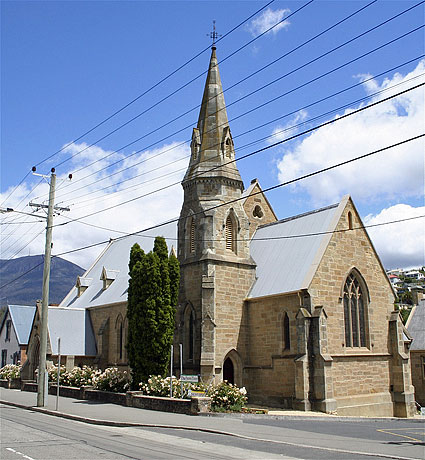
All Saints' Anglican Church, South Hobart
[Photograph by Trevor Bunning (December 2008)]
Historical and Technical Documentation by John Maidment
© OHTA 2008, 2018 (last updated June 2018)
The foundation stone of All Saints Church was laid on 2 December 1858 and the building was opened on 18 August 1859.1 This sandstone Gothic Revival building is a good example of an unpretentious church and hall designed by Henry Hunter.2

Current casework of the Bishop, Starr & Richardson organ
[Photograph by Trevor Bunning (December 2008)]
The organ was built by Bishop, Starr & Richardson of London, and installed in October 1862 by Jesse Biggs of Launceston:
THE NEW ORGAN IN ALL SAINTS CHURCH.
A very beautiful organ, built by Bishop, Starr, and Richardson, after a scheme by Mr. F. A. Packer, has just been erected by Mr. Biggs in All Saints' Church, Macquarie-street.
This instrument has two manuals. The great organ extends from CC to F in alt, and the Swell from tenor C to F. in alt, and two octaves of Pedals from CCC to D. There are also three composition pedals and two couplers, viz., "Swell to Great" and "Great to Pedals."
In the construction of this instrument every facility has been given for tuning and giving access to different parts, and the whole of the mechanism is finished in a very superior manner.
The following shows the scheme of the organs as well as analysis of each stop :
GREAT ORGAN.
Open Diapason.-This stop extends throughout the whole organ, and is of a scale suited to the rest of the instrument.
Dulciana.-This, extending from Tenor C to F in alt, is of exquisite tone and possesses the rare qualification of remarkable quickness of speech.
Stop Diapason, Bass.-This stop is distinguished by great fulness and depth of tone, and tells well in the building.
Clarabella.-The builders are the inventors of this stop, which is of fine tone, superior, if anything, to the Clarabella in the organ in St.David's Cathedral, Hobart Town, by the same builders.
Principal.-This stop, as its name implies, is the chief stop of the instrument. It is distinguished by its brilliancy of tone.
Fifteenth.-This is also of brilliant quality.
Sesquialtra (Three Ranks).-This stop, contrary to most others of its name, is of-subdued tone, blending admirably with the full organ, without being too prominent.
Flute.-The sound board is pierced for this stop, which is expected to arrive in a few months.SWELL.
Double Diapason (16 feet tone.)-This stop is of wood, and imparts great fulness and depth of tone to the swell.
Open Diapason.-A metal stop of good scale and fine tone.
Principal.-Of the same quality as the principal on the Great Organ.
Hautboy.-This reed stop is of excellent quality, possessing remarkable smoothness and richness, and is totally free from the braying character of many reeds of this class. It also responds with great quickness to the touch.PEDAL ORGAN.
Grand Open Diapason (16 feet.)-This stop will arrive from England with the Flute in the Great Organ, and will thus render the instrument oven more complete than any of its size in the colony.GENERAL REMARKS.
The different stops are extremely well balanced throughout. The instrument combines sweetness with great power, and when the full Swell is coupled to the Great Organ, the effect in the building in which it is placed is equal to that produced by much larger instruments.3
The organ was opened on 20 October 1862. The organist was F.A. Packer.4
In 1891 the soundboards were remade and restoration work was carried out by George Fincham. In 1904 the Swell Double Diapason 16 was transposed to a Stopped Diapason 8 by Geo.Fincham & Son.5 In 1920 the action was converted to tubular-pneumatic by Geo.Fincham & Son of Melbourne at a cost of £435. Two stops were added to the Swell: a Viol d'Orchestre 8 and a Voix Celeste 8.6
In 1963, Davis & Laurie Pty Ltd of Launceston converted the action to electro-pneumatic and installed a new console. A Salicional 8 was added to the Great Organ and a Bourdon 16 to the Pedal Organ (ex St David's Cathedral), and several pedal stops were extended.7
In 1974 the organ was moved to a new position in the church by Long, Langlois & Johnstone of Hobart. New casework was provided and the console remade.8
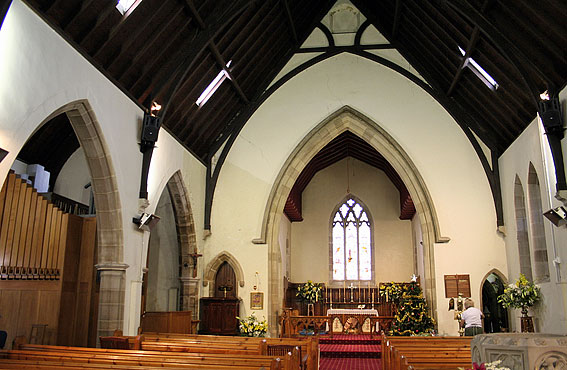
The organ in its new position after 1974
[Photograph by Trevor Bunning (December 2008)]
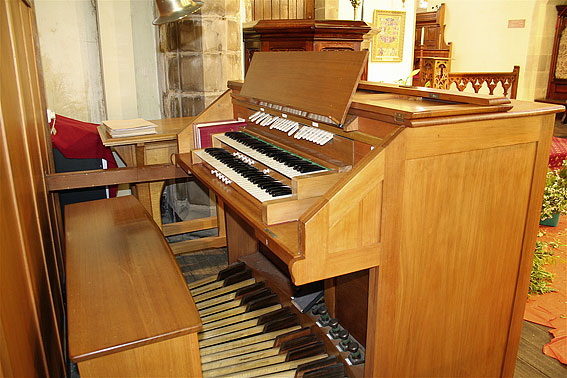
The 1963 console by David & Laurie, remade in 1974
[Photograph by Trevor Bunning (December 2008)]
The whole of the original Bishop, Starr & Richardson pipework survives, albeit with new action, soundboards, console and casework.
The current specification is:
| Great Open Diapason Claribel Dulciana Salicional Principal Flute Fifteenth Mixture Swell to Great Swell Open Diapason Gedeckt Gamba Viole Celeste Principal Oboe Swell Sub Octave Swell Super Octave Tremulant Pedal Open Diapason Bourdon Octave Bass Flute Fifteenth Great to Pedal Swell to Pedal.9 |
8 8 8 8 4 4 2 III 8 8 8 8 4 8 16 16 8 8 4 |
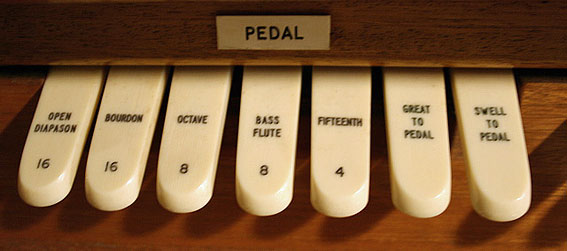

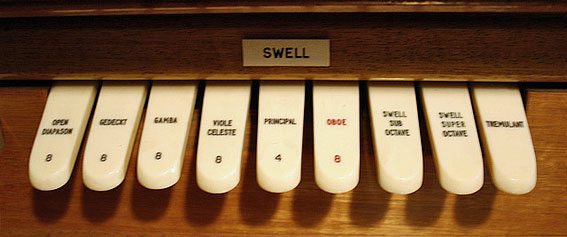
Details of the stop-keys after 1963
[Photograph by Trevor Bunning (December 2008)]
1 All Saints Parish Church South Hobart - brochure on Sesquicentenary Year 1859 - 2009.
2 The Heritage of Australia – The Illustrated Register of the National Estate, by Australian Heritage Commission (South Melbourne: Macmillan Company of Australia, 1981).
3 Mercury (15 October 1862), p. 5.
4 Ibid. (21 October 1862), p. 5.
5 E.N. Matthews, Colonial Organs and Organbuilders (Carlton: Melbourne University Press, 1969), p. 197.
6 Brian Clark & Michael Johnson, Pipe Organs of Tasmania. 3rd ed. (Hobart: Hobart Organ Society, 2002) organ no. 2.
7 Ibid.
8 Ibid.
9 Specification supplied 1970 by Robert Heatley, Melbourne, and from photographs by Trevor Bunning (December 2008).